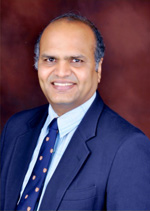Lee Hsun Lecture Series

Topic: Fracture in amorphous alloys
Speaker: Upadrasta Ramamurty
Department of Materials Engineering,Indian Institute of Science
Time: 10:00-11:30, (Fri.) May 26th, 2017
Venue: Room 468,Lee Hsun Building, IMR CAS
Abstract:
The mechanical properties of amorphous alloys have proven both scientifically unique and of potential practical interest, although the underlying deformation and fracture physics in them remain less firmly established as compared with crystalline alloys. In this presentation, I shall review the recent advances we made in understanding the fracture behaviour of metallic glasses. In crystalline metals and alloys, the term ‘ductile’ is synonymous with ‘tough,’ as they both are linearly correlated. However, the non-existence of such correlation in metallic glasses poses a conundrum. For example, bulk metallic glasses (BMGs) with no tensile ductility whatsoever can exhibit extraordinarily high fracture initiation toughness values. “What is the physical reason for such high toughness?” is a question that we set out to answer. A related issue is the following: A material physics-based condition, at which fracture will initiate, is essential for reliable design of components and structures. Fracture criteria for brittle materials like ceramics are stress based whereas those in ductile materials like metals and alloys are strain based. But, both need the identification of a critical length scale, l*, which is related to some microstructural length scale, to be prescribed apriori. A suitable fracture criterion is needed to identify l* at which plastic to brittle transition takes place. Mixed-mode fracture experiments coupled with detailed finite element simulations are conducted identify the fracture criterion in a nominally ductile BMG. These results show that fracture in amorphous alloys is controlled by the attainment of a critical strain and that a stable crack grows inside a shear band at the notch root before attaining criticality at l*60 m. The Argon and Salama model, which is based on meniscus instability phenomenon at the notch root, has been modified to rationalize the physics behind this length scale. This model suggests that the mean ridge heights on fractured surfaces were found be correlated to the toughness of the BMG. In contrast, the fracture mechanism in brittle metallic glasses is elusive. Some interesting morphologies observed on brittle fracture surfaces will be presented.
Biography:
Upadrasta Ramamurty is a Professor in the Department of Materials Engineering, Indian Institute of Science (IISc), Bangalore, India. He obtained Bachelor’s and Master’s degrees in Engineering (both with Metallurgy as the major) in 1989 and 1991 from the College of Engineering, Andhra University and IISc, respectively. Then he joined Brown University to obtain a PhD in 1994 under the supervision of Professor S. Suresh. Subsequently, he worked as a Post-doctoral Fellow at University of California – Santa Barbara and MIT, and worked as an Assistant Professor for three years in the School of Mechanical Engineering, Nanyang Technological University, Singapore. He returned to IISc as faculty in October 2000 where he teaches and does research in the broad area of mechanical behavior of materials. His current research interests include deformation and fracture behavior of amorphous as well as crystalline alloys, additive manufacturing, and the development and application of the nanoindentation technique. He published more than 230 papers in peer reviewed international journals and is an editor of Acta Materialia and Scripta Materialia journal. He is a Fellow of the Indian National Academy of Engineering, the Indian Academy of Sciences, and TWAS: The World Academy of Sciences, and is a recipient of the Scopus Young Scientist and National Metallurgist Day awards, Shanti Swarup Bhatnagar and TWAS prizes (both in Engineering Sciences category), and Swarnajayanthi and JC Bose National Fellowships. He delivered the CNR Rao Prize Lecture in Advanced Materials of the Materials Research Society of India. He is an Honorary Professor at the International Centre for Materials Science, Jawaharlal Nehru Centre for Advanced Scientific Research, India and Qiushi Distinguished Visiting Professor of Zhejiang University, Hangzhou, China.